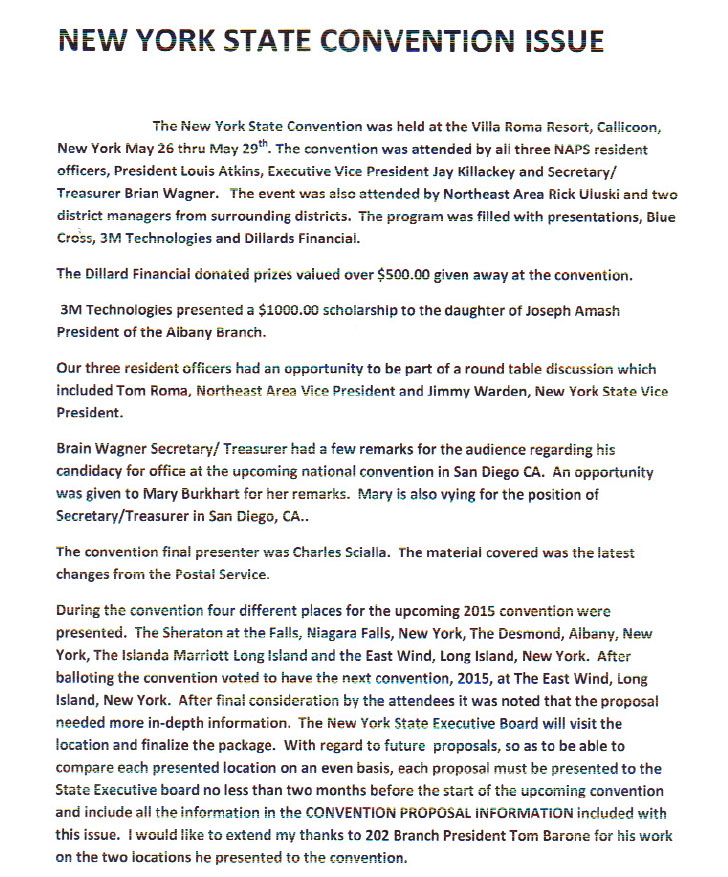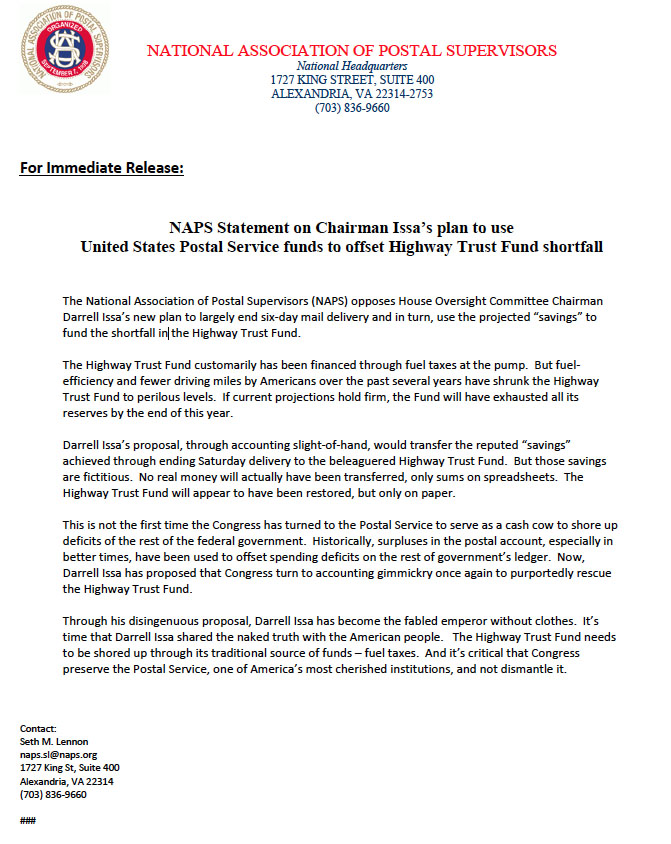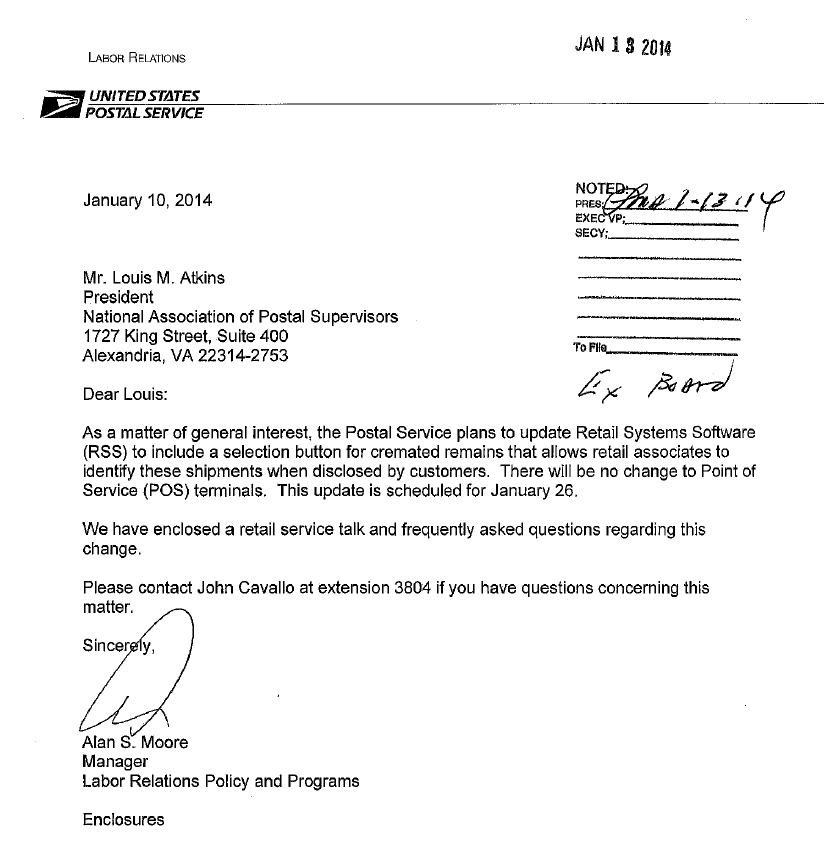NY State Convention – Important Information
- in News

A VIEW FROM THE BRIDGE




 NAPS Leg/Reg Update – May 21, 2014
NAPS Leg/Reg Update – May 21, 2014
The House Oversight and Government Reform Committee today approved cost-savings legislation that would require the Postal Service to convert door delivery at 15 million homes and businesses to lesser expensive delivery options over the next ten years. The approval of the “Secure Delivery for America Act” (HR 4670) came on an 18-13 vote, split along party lines.
Rep. Darrell Issa (R-CA), chairman of the House committee and sponsor of the bill, said the measure was a “targeted, flexible and data-driven way to save the fiscally-troubled Postal Service several billion dollars a year.” He said the bill also provided mail security to USPS customers.
Committee Democrats countered that the measure would be impossible to implement in urban areas, where adequate space for mail receptacles is hard to find and would install pricing for services that Americans were accustomed to receiving without charge. (The Issa measure would allow postal customers to retain door delivery for an unspecified fee.) Panel Democrats also criticized Issa for not including the proposal within a larger postal legislative package that addressed more pressing postal issues, including adjusting the Postal Service’s retiree health prefunding payments, returning the FERS retirement surplus to the Postal Serivce, and permanently mandating six-day mail delivery. Their efforts today to add these provisions to the bill were ruled out of order and non-germane by Issa on parliamentary grounds.
Issa acknowledged the need for a comprehensive bill, but noted that his draft proposal several weeks ago, which matched the Obama White House’s postal reform proposals, could not attract support from other House GOP members. Issa said he was likely, instead, to craft a new postal reform bill based on measures that have won support in his committee, like today’s measure (HR 4670) and Alaska bypass mail (HR 4174). Given the difficulties of postal politics in an election year, the success of that strategy remains uncertain. In the Senate, the committee-approved postal reform bill (S. 1486) continues to languish, poisoned by a firearms provision that has discouraged Majority Leader Reid from bringing the measure to the floor.
Overall, the outlook for action on postal reform in the 113th Congress remains cloudy. Observers in Washington point to a potential lame-duck session, following the November elections, as a possible time for action; they note that the timing of passage of the 2006 postal law also occurred during the lame duck session following that year’s mid-term elections.
=====
Bruce Moyer
NAPS Counsel
[email protected]


NAPS Leg/Reg Update – May 20, 2014
Rep. Darrell Issa (D-CA), chairman of the House postal oversight committee, has shifted gears. After GOP members of his committee balked at his recent, scaled-down postal reform proposal, he’s come up with another idea — one aimed at converting residential and business door delivery to less expensive options, primarily curbside or centralized delivery.
Issa is preparing to push his “delivery point modernization” proposal through his House postal oversight committee on Wednesday, on a likely party-line vote. (A draft version of Mr. Issa’s proposal is here.)
NAPS opposes the Issa proposal for falling short of the comprehensive reform the Postal Service needs. In a statement released today, NAPS Louis M. Atkins said, “There is wide consensus that comprehensive postal reform requires, first and foremost, realigning the retiree health prefunding payments schedule, which has been a massive burden upon the finances of the Postal Service. Rep. Issa’s proposal does nothing to address that burden.”
Atkins also said, “Rep. Issa’s proposal heads in the wrong direction; it provides no funding for the Postal Service’s purchase and installation of hundreds of thousands of curbside and centralized delivery boxes, nor the funding to provide for right-of-way placement of those boxes. These up-front costs will only drag down the Postal Service’s finances further.”
A GAO report released last week notes that the Postal Service estimates it could achieve more than $2 billion in annual savings by mandatory conversion of 12.2 million door delivery points over the next decade to a mix of centralized and curbline boxes. However, GAO questions the accuracy of that cost esimate because it relies on 20-year-old data. Issa’s proposal would require the Postal Service to end door delivery to 15 million residences and businesses over the next ten years.
Nonetheless, Issa appears ready to charge ahead, asking questions later and taking political cover under a White House door delivery conversion proposal contained in its FY 2015 budget. Issa’s proposal, unlike the Administration’s, would charge postal patrons (an unspecified amount) who want to retain “legacy” door delivery.
The Carper-Coburn postal reform bill in the Senate, which was approved by the Senate postal committee in February, also would encourage door delivery conversion, but as part of a comprehensive set of reforms. The Senate bill is stranded and unlikely to reach the floor because of a “poison pill” provision, concerning guns in postal parking lots, inserted by Sen. Rand Paul (R-KY) during committee markup.
Door delivery today represents a little less than one-third of all USPS delivery points. According to USPS data, about 41 percent of current delivery points receive curbline delivery, about 30 percent receive centralized, and about 28 percent receive door delivery. Issa’s bill would go after that 28 percent.
All new residential development construction provides for the installation of centralized mail delivery, and there are voluntary provisions for the conversion of door and curb delivery to centralized delivery. “This should remain the governing approach until Congress musters the will to undertake comprehensive postal reform,” NAPS President Atkins said.
=====
Bruce Moyer
NAPS Counsel
[email protected]




Quarterly Business Meeting – CHRO Jeffrey Williamson – NAPS Resident Officers
April 29, 2014
Attendees:
Jeffrey Williamson – USPS Chief Human Resource office/Executive Vice President
Doug Tulino – USPS Vice President, Labor Relations
Jay Killackey – Executive Vice President, NAPS
(Louis Atkins was unable to participate in the meeting due to travel disruptions on his return from the North Dakota/South Dakota States Convention. Brian Wagner was on travel to a previously scheduled meeting)
The agenda items included:
1. Update on the filling of EAS Vacancies
Over the past month the USPS has posted in excess of 1,000 EAS vacancies and will continue to post vacancies as quickly as possible.
2. Update on training for new supervisors
NAPS received a briefing as part of their recent executive board meeting that the USPS is currently conducting a thorough review of the current New Supervisor Training Program. NAPS will place this item on our May Consultation so that NAPS can meet with the principles of this program for an update
3. Discussion on the likelihood of a NPA Buyout for FY 2014 based on current data and metrics.
We are currently in the beginning of PQ3/14 and despite having a rough PQ2/14 as a result of weather impacts the USPS expects to bounce back strong in PQ3/14.
4. Overtime issues in the Los Angeles Customer Care Call Center; EAS 19 supervisors are being required to work consistently on their off day and there have been reported instances of customer issues being referred back from the call center to post offices/stations due to the excessive volume. We would like to discuss staffing levels at the care facilities and what can be done to improve them.
The USPS has received these reports from the leadership of the Call Centers as they adjust the staffing to the workload. NAPS will place this on the May, 2014 Consultative Agenda so that a briefing can be provided to NAPS by the leadership of the Call Centers.
5. NAPS received a report of where an EAS manager was physically assaulted by a carrier in the Louisiana District. The incident was resolved by the district by agreeing to return the carrier to work. We would like to discuss protocols regarding these types of incidents.
USPS HQ Labor Relations will look into this issue and requests that NAPS contact the District Manager in the Louisiana District to gain additional information.
Open Discussion:
The meeting attendees then held an open discussion about the benefits of holding quarterly meetings that are in addition to the monthly Consultative meetings that are held in compliance with Title 39. It was agreed that open communications is necessary between NAPS and the Postal Service. Quarterly meetings provide opportunities to discuss strategic issues that are important to both the Postal Service and members of NAPS.
The meeting attendees discussed plans for the 2015 PFP where there will be an increased focus on the entire process directly from the CHRO, Jeff Williamson. The development of goals and objectives for PFP in 2015 will be simplified and the processes for developing goals will be more transparent. Mr. Williamson stated that he expects NAPS to play a greater role in the 2015 PFP process.
The discussion then turned to the shortcomings of the current New Supervisor Program and plans to come up with a solution as to how to best make changes in the current program. NAPS recommended that the development process should include representation from NAPS as part of the work team. This recommendation from NAPS will be considered as decisions are made to overhaul the current program.
There was a discussion on the improvements in the application of the Doug Tulino letter outlining compliance with the requirements for placing EAS employees in off-duty states without pay. As a result of this letter there has been a reduction in instances off EAS employees being placed in an off-duty status without pay. Doug Tulino requested that any problems in this area should be brought to the attention of his labor relations staff so that a review can be conducted.
Both Tulino and Williamson expressed that issues that may arise in the field do not have to wait for either the quarterly meetings or the monthly consultative meetings. If an issue arises they expect that we contact their offices with as much information as possible so that the issue can be investigated and resolved.

